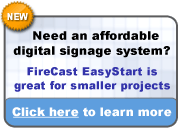 A new gun for hire: ex-DigitalView/Enqii sales monkey extraordinaire and esteemed blogger colleague Dave Haynes (seen here in an undated photo apparently during a stint as a used car salesman) is now ex-BroadSign too, as apparently the firm is shifting to an all-channel-sales model. While he muses that he's not sure what he'll do with himself next, I think the answer is obvious: team up with Lyle Bunn and Bill Collins, find a good tenor, and form the first-ever, all-Canadian digital signage consultants barbershop quartet.
A new gun for hire: ex-DigitalView/Enqii sales monkey extraordinaire and esteemed blogger colleague Dave Haynes (seen here in an undated photo apparently during a stint as a used car salesman) is now ex-BroadSign too, as apparently the firm is shifting to an all-channel-sales model. While he muses that he's not sure what he'll do with himself next, I think the answer is obvious: team up with Lyle Bunn and Bill Collins, find a good tenor, and form the first-ever, all-Canadian digital signage consultants barbershop quartet. You do want that big, fat discount on Strategy Institute's Content Strategies show, right? Today's March 31st, which means it's the last chance to qualify for the $500 early bird discount. And remember, Digital Signage News readers can get another 10% off by entering the code DSN10 at the time of registration.
Paul Flanigan of BestBuy and Experiate fame appearently learned 5 Things at GlobalShop, including my favorite, "I did not know there were so many ways to hang stuff in a store."
In-store gaze tracking to figure out what people are looking at is already obsolete.... well, ok, not quite yet, but soon, if Martin Lindstron's "Buyology" program can solve a few technical hurdles (among the most noteworthy might be how to carry around brain-scanning equipment that doesn't look like a shower cap crossed with a medieval torture implement). After all, why track people's eyes in real time when you can track their brains, right?
Tags: digital signage, digital signage news
Looking for more digital signage info? Check out WireSpring's Kiosk and Digital Signage blog for in-depth industry analysis and even more news about the digital signage industry. While you're there, feel free to read up on our digital signage software and services



 POPAI's Digital Signage Contest went off without a hitch at GlobalShop this week. The Digital Display of the Year winner, MODERNISTIC, did a pretty awesome "living standee" using 3M's Vikuity holographic projection film and put the thing in the Mall of Americas. While technically the piece was quite simple (project an image of a living, talking, sales-pitching person onto a person-shaped piece of film, the results were spectacular, and apparently people were showing up to the still unfinished Best Buy store just because the projection told them to (oops!).
POPAI's Digital Signage Contest went off without a hitch at GlobalShop this week. The Digital Display of the Year winner, MODERNISTIC, did a pretty awesome "living standee" using 3M's Vikuity holographic projection film and put the thing in the Mall of Americas. While technically the piece was quite simple (project an image of a living, talking, sales-pitching person onto a person-shaped piece of film, the results were spectacular, and apparently people were showing up to the still unfinished Best Buy store just because the projection told them to (oops!).









 Subscribe to this blog
Subscribe to this blog Follow Bill Gerba on Twitter
Follow Bill Gerba on Twitter